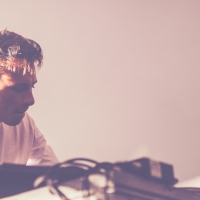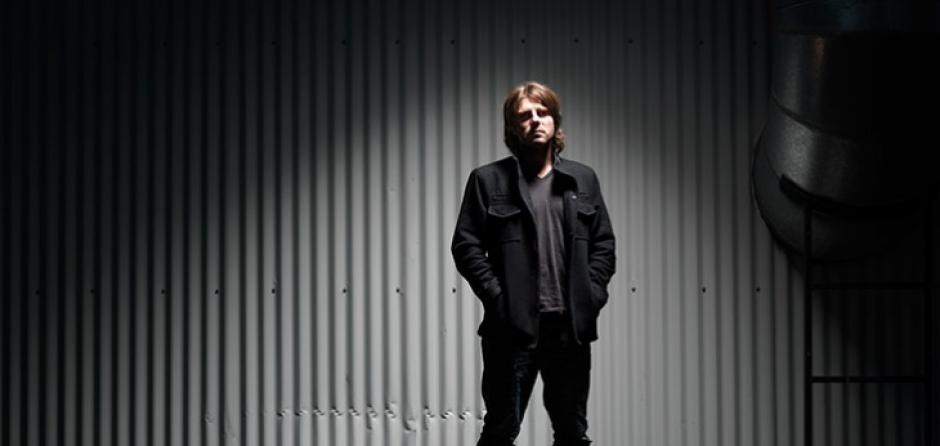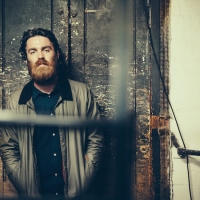 Finding A Future ClassicLiam Apter goes to the men behind Flume's massssssive year.
Finding A Future ClassicLiam Apter goes to the men behind Flume's massssssive year.

Leigh Carmichael Is One Dark Mofo
We speak with Leigh Carmichael, a passionate Tasmanian and Creative Director of Dark Mofo, MONA’s winter festival.
Tasmania in my experience has always had a bit of an average reputation, although I think over the last few years, Tasmania has been slowly warming to the people who used to heap shit on it. I really want to go and if it wasn’t for my bank account being near empty for the last couple of years I probably would have already. I want to go for MONA, for DARK MOFO, for the whiskey, for the wine, for the produce, for the bands, for the hiking trails, for the scenery, the mountains, the rivers, that’s all I can think of right this minute but you get the point. I think it’s popularity surge can be put down to MONA and in turn David Walsh, the millionaire driving force behind it, *Low Five David Walsh. If you are planning on going soon, go for DARK MOFO the annual winter festival, it’s one of the better-programmed festivals I have seen, it's Creative Director Leigh Carmichael and his team have done a serious job. *Low Five Leigh Carmichael. I recently had a pretty long chat to Leigh about MONA, DARK MOFO and his path through the creative industries.
How did you get your start in design and the creative industries?
Yeah I went through Uni here and majored in Graphic Design at the Tasmanian School Of Art, and I decided to stay in Hobart, which is a bit unusual. Most graduates end up interstate because there’s not a lot of work here. But I chose to stay, which has worked out well now. There’s not a lot of work down here but I did build up a good portfolio over 10 years. As a freelancer David Walsh contracted me to design the Moo Brew beer labels, and then that moved into a full time contract on the museum.
At what age did you start freelancing?
Pretty young; I did three years with a small design agency called G3, working on interesting projects like the Who Is James Boag? Campaign… That was a boutique design agency, and I was always interested in more the design side than the commercial side of advertising. I did that for two or three years and then went out on my own pretty young, like early 20s.
Did you find working in the studio prepared you for freelancing?
Not really [laughs]. I certainly felt like I needed a few years. I wasn’t really prepared for freelancing in terms of running a business, I found that pretty challenging. I managed to be always busy, and doing good work – work that I was proud of. I’m not sure how good it was looking back [laughs] but I certainly gave it everything that I had. So I was busy, but certainly never made any money.
It’s pretty tough, really tough actually. By the time I was 30 to be completely honest I’d made no money, had young children, and was kind of regretting not leaving [Tasmania]. My friends were coming back, they’d been to London, worked in Melbourne… They’d just done interesting things and they’d been paid for their experience and I just felt like I’d made the wrong decision. But what I did do was learn a lot, gained a heap of experience and had a pretty good folio at my own expense – I’d often work for two or three weeks or longer on projects that I was only getting paid two or three days for. But I had a real desire to make sure everything I did was as good as I could make it. So I had a good folio, and that’s what handed me the gig with David. And I also think he saw someone that was kind of entrepreneurial, which suited his way of working.
Yeah I think you kind of have to be when you’re a graphic designer don’t you?
Yeah I love that. When I got the gig with David I wasn’t actually looking for a full-time job really. I didn’t want one but I certainly needed some money, and I always love working with clients on projects and creating things. So the last thing I wanted to do was lock myself down to one job, but it turned out be… I just feel really fortunate I was in the right place at the right time. I guess I’d done a lot of groundwork.

What was the initial spark for Dark Mofo, and how did it develop from there?
To put it into context, we started MONA FOMA, our summer festival, three years before the museum opened, and that was another project that I initiated. And that was based on the fact that David Walsh doesn’t like spending money on marketing. Never has, still doesn’t. He especially doesn’t like advertising. So we were trying to build up a profile, and raise awareness, and I don’t think we were really thinking about brand experience. But we were wanting to build our database and be known and make a noise and attraction some attention prior to the museum opening. So instead of putting our money into marketing/advertising campaigns we decided to run a festival as a way of just doing something. And it gave us something to talk about at the same time. The point is we spent about 90% of our marketing and advertising budget on the festival initially. And it actually worked. By the time the museum opened, we had three years event and festival experience, we built up a strong database, and built up a support base I guess of people that liked what we were doing. As a marketing exercise it worked as well. It gave us a national profile, people in festivals you know the artists talk about what they’re doing to their own networks etc. And from David’s point of view it’s a lot more fun spending money on a huge party than a huge billboard.
So that’s how the first festival started, and we ran through to the museum opening in 2011 – I won’t go into the MONA story, but that’s been quite successful and we’ve had over a million visitors over the last three years. But what we found during those first three years, is that we were having issues with winter visitation. So we thought well we don’t do advertising campaigns so let’s not even bother with that. So what we should do, if we’re going to do a major exhibition each year? Why don’t we launch that in the middle of winter and build up a kind of mini-festival around it as a marketing exercise; a good way to attract attention to a brand experience beyond the museum walls. We decided if we were to do that model we’d need support from the government. To do something good at scale is quite expensive, so we put the proposal together. So our commitment is to run the thing, program it, and also to launch a major activity or project in the middle of winter out at MONA which adds three months a three-month life span to the whole thing, not blow up your money in ten days and it’s gone.
That was the initial spark, and that kind of grew, and then we looked at interesting ways to make it unique. So because the whole idea was to take on winter, we decided to embrace it to our advantage. It’s exceeded all our expectations as to how it’s played it.
Embracing the cold, the darker side of things I guess it appeals to a different kind of person as well…
Yeah the thing for me is, the themes that David is interested in with regards to the museum is things like sex and death, to simplify it - kind of the darker themes. I’ve always been a massive David Lynch fan - he’s an idol I guess, and I think exploring darker space is more interesting. And so all those things just come together. As soon as we named it Dark Mofo people got it instantly. And we know that from the kind of proposals that are coming in. And when I saw the proposals coming in I was like, ‘I think we fucking nailed this’ [laughs]. People are onto it. They got what we were trying to do before we’ve even done it. It’s resonating.

Does the programming reflect your tastes?
Yeah for sure. Because we had longer to line-up some of the artists we wanted. Sunn O))) I was trying to get last year, but we got them this year, which is great. Also the classical stuff. There’s so much. The thing I’m most interested in, it was interesting because I’ve been reading about it for years before Dark Mofo came along, is the ritual element, the coming together. I subscribe to David’s views. I am an atheist, but I think that when you take religion away, it kind of leaves a hole in terms of – not moral shit, that can survive without religion – but some of the coming-of-age rituals, the community celebrations; I think there’s a need to replace those with something. That secular kind of ritual ceremony stuff – I’m just interested in that and what it can do with people, those moments of contemplation about things.
So whose idea was it include Yo Gabba Gabba?
They were available, and someone said they’re available for a joke, but almost instantly it’s like that’s going to work. Intuitively it felt right, obviously it’s great to do something for the kids. I just think Yo Gabba Gabba is perfect for Dark Mofo - I love the contrast, and I think the worst thing we could do is do everything dark and black. I think you need moments of humour and light and diversity within the program as well. A bit of light in the dark. I’m so happy that Yo Gabba Gabba are in [laughs].
What are you most proud of professionally of your time at Mona?
Dark Mofo - because we’ve exceeded all our expectations, it felt like a high point for MONA. I’ve had people come up on more than one occasion saying they were still unsure about MONA until they saw Dark Mofo and what it can do for a community, because it was just an amazing thing to be here in the middle of winter. It was a bitterly cold week, and to see families, so many people out, at night, walking the streets of Hobart with fire and food and just enjoying, and seeing Hobart in a new light. Even potentially seeing winter in a new light, it was so rewarding. I get a massive buzz out of that. And it’s exceeded what we thought it would be like.
I think we hoped it would change people’s perception of winter in three or five years, but it just seemed to happen. People are looking at winter as an opportunity now, because of us. So yeah I’m really incredibly proud of Dark Mofo and its program. It feels like it’s on theme and its exploring something interesting. I think it’s a space we can play in for many years and not even scratch the surface. Of course I’m proud of work on MONA as well, but for me personally Dark Mofo is the one I grabbed and gave birth to right from the start.

When doing the heavy design work back at the beginning, what were your inspirations?
Well David sent me down the bacchanalian, Bacchus-on-ice kind of path, so that was a massive influence. Instead of looking at design books and other museums, we looked at religion – non-commercial branding, certainly the Catholic or the Christian branding, with the cross, they do tiles, architecture, the WHOLE thing is incredibly well branded, and doesn’t appear commercial at all. It is a business [laughs]. They might not have to pay tax but it’s still a business. I certainly looked very closely at all religion really for inspiration.
What do you enjoy most about where you live in general?
I absolutely love Hobart, and with this role for the last eight years I’ve been fortunate to get out regularly. I get to see a lot of stuff in Melbourne and Sydney, and getting out is great but I absolutely love Hobart. I love the landscape, I love the scale. We’ve got a really great food and wine culture. You really don’t know how good our food is till you get out, it’s fresh, good produce, lots of boutique suppliers – handcrafted, hand grown food-to-plate things is big here. Low food miles. So I love that culture, we’ve got a good coffee culture now. And the architecture/design/fine arts scene is thriving at the moment. It’s only small but it’s high quality. And we’re not many minutes drive from country and wilderness areas, I love getting out and bush walking, rafting on the Franklin. I just think it’s a great, affordable place to live, and it’s pretty close to Melbourne. I’m so glad I stayed, I love Hobart, and if I can continue to stay here I will.
What is there about the creative industries you work in that could use a good kick in a different direction?
I think, in the museum world for example, the thing that needs a kick is the committees. I think there’s a place for them in some areas, like OH&S, financial risk and that kind of thing. They just don’t mix well with creativity and innovation, and the problem is they even out, they just have this ability to suck the life out of creatives [laughs]. And I just don’t think they should be empowered. I love whiteboard sessions and creative ideas – we get together regularly as a group and throw big ideas around, and I love all of that, but as soon as you form a committee and give it any sort of power it just likes the life out of creativity and innovation and I just think that needs to be… just the models need to be looked at. Breaking down that really slow, bureaucratic thing that happens in larger organisations. It’s really hard to say and hard to do, but I definitely think there’s a role for CEOs or museum directors at where to empower creative, and work out other ways to limit the risk, as opposed to creating a 10-person committee - they kill it at the same time as they make it safe.
___
DARK MOFO runs from June 12-22. See darkmofo.net.au for ticketing and all the details.
For more information on MONA and what they have coming up mona.net.au
 Finding A Future ClassicLiam Apter goes to the men behind Flume's massssssive year.
Finding A Future ClassicLiam Apter goes to the men behind Flume's massssssive year.
 Life On The Road with Chet FakerPeer behind the curtain of life on the road in the wake of one of 2014's best LPs.
Life On The Road with Chet FakerPeer behind the curtain of life on the road in the wake of one of 2014's best LPs.